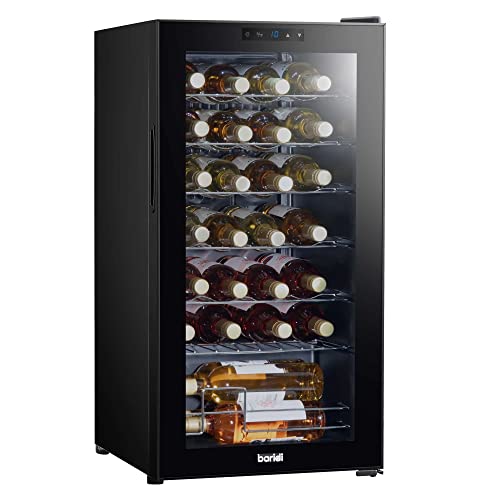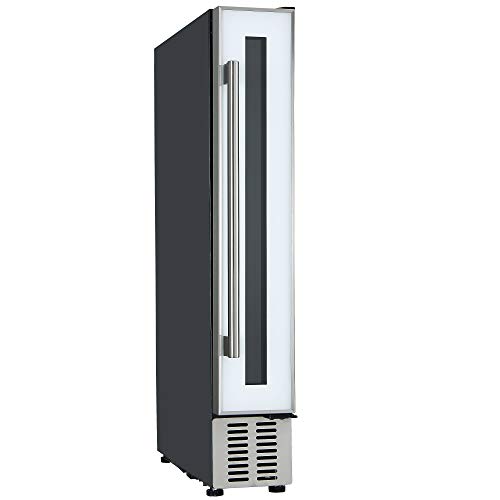15 Terms Everybody Involved In Wine Cooler And Fridge Industry Should Know
작성자 정보
- Celina 작성
- 작성일
본문
 How a Wine Cooler and Fridge Can Help Preserve Your Cabernet Sauvignon and White Zinfandel
How a Wine Cooler and Fridge Can Help Preserve Your Cabernet Sauvignon and White ZinfandelKeep your Cabernet Sauvignon and White Zinfandel at their ideal serving temperatures by using wine refrigerators. Some, like the KitchenAid(r) Undercounter electric wine chiller Cellar also regulate humidity levels to help protect labels and wine from mould.
 Traditional refrigerators can be harmful to the flavor of your wine. This is the reason wine fridges are readily available.
Traditional refrigerators can be harmful to the flavor of your wine. This is the reason wine fridges are readily available.The Ideal Temperature
A wine refrigerator is a fantastic way to store a collection of wines at the perfect serving temperature, making it easy for you to serve them at their peak. The temperature of the wine should be maintained constant and stable to help preserve the flavour and aroma of the wine, while slowing down the process of aging. The temperature of the wine should be slightly lower than the room temperature to prevent the wine from becoming too cold and losing its flavor.
The best wine coolers are designed to keep the temperature between 54 and 57 degrees Fahrenheit (11 and 14 Celsius). This temperature range is ideal for storage over a long period as it slows down the aging and prevents the wine from drying. The temperature shouldn't be too high, as this could cause oxidation or other problems.
You can utilize a single-zone wine fridge that can keep all your Wine Chiller Kitchen collection or, alternatively, you can purchase a dual-zone wine fridge which allows you to divide the wine into two different zones for better control of the temperature. For instance, you could keep your red wines in one region and your white wines in the other, so that you can easily serve them at the perfect temperature for each type of wine. This will enhance your drinking experience and make it easier to prepare a cocktail party or dinner, as you simply need to move the bottles into the proper zone prior to the night before.
Certain models of wine refrigerators will come with a user's manual that contains specific information about temperature settings. It is essential to read this document carefully to become familiar with the specific temperature control features of your wine cooler. It is also a great idea to monitor the temperature of your wine refrigerator frequently since it is prone to fluctuation. It is recommended to keep the wine refrigerator in a location away from heat and sunlight sources which will help to prevent the interior of the fridge from getting too hot. It is advised to not open the wine refrigerator often because this can cause the temperature to fluctuate.
Control of Humidity
Humidity plays an important part in wine storage. Low humidity levels cause corks to dry out, which compromises the seal and allowing oxygen in to enter the bottle. This can alter the taste of the wine and lead to off-flavors. The high humidity levels encourage the development of mold and mildew and can also alter the labels on wine bottles. A wine cooler that has integrated humidity control will help you to achieve optimal aging conditions for your wine collection.
The ideal range of humidity is 50 to 50% to. Certain wine refrigerators come with the ability to dehumidify which assists in controlling humidity. It helps remove excess moisture. This is important as high levels of humidity could affect the quality and readability of wine labels. In addition constant humidity levels encourage even aging of your wine collection and aid in the development of complex flavors as time passes.
Humidification techniques for your wine fridge are easy and easy to implement. The most popular method is to put a small tray of water in the bottom of your refrigerator. Over time the water will evaporate, increasing the humidity of your wine refrigerator. You can also utilize humidifiers designed for small spaces. Many are energy-efficient and offer an adjustable humidity setting.
Baking soda is an alternative. It is a natural absorbing of moisture qualities. You can open a container and put it in a strategic location inside your refrigerator to minimize excess moisture. You can also make use of silica gel packs which are often used to pack electronic items as well as food items. Make sure to replace these periodically.
Certain wine fridges come with built-in humidity control systems that automatically regulate moisture levels based on pre-set parameters. These systems are more precise than passive methods, and can be especially useful in the case of an extensive wine storage space with different humidity requirements for various types of wine. Finally, professional wine cellars are equipped with cooling systems which provide a controlled environment for aging your wine collection. They are generally best suited for premium wines that require a stable environment to age.
Noise Reduction
Wine coolers and refrigerators are a great investment for those who wish to keep the quality of their wines. During operation, however these appliances can generate some noise which could cause disruption or distraction. There are several steps to minimize the amount of noise these units produce.
One of the major sources of noise that comes from wine refrigerators is the compressor cycling. The process involves circulating refrigerant to cool the interior of the fridge, and could result in groaning and buzzing sounds. It is therefore essential to place the fridge on a flat, level surface to avoid vibrations and noise.
Internal Vibrations
The rattling and scraping noises caused by bottles hitting each other or the shelves is another common source of noise from the wine refrigerator. This can be minimized by making sure that the bottles are properly stored and packed together to minimize movement. It is also helpful to make use of wooden shelves or racks rather than metal to help absorb some of the sound.
The proper ventilation will also reduce the level of noise that is emitted by the wine refrigerator. It is also essential to regularly clean the fridge to remove dust and debris that may build up and impede the flow of air. In addition, it is recommended to put an isolation pad made of rubber under the fridge to keep it from the hard floor and help minimise any vibrations that can create noise.
Wine refrigerators typically emit between 35 and 45 decibels during normal operation. This is comparable to background noise in a quiet suburban home or library, and is considered as a moderate amount of noise for a device.
If you're experiencing a wine fridge that is producing louder than normal noises, it's recommended to refer to the troubleshooting guide provided by the manufacturer or call a technician for repair visits. This will determine whether the appliance is operating as it should, or if a more serious issue is present. The technician will be able to diagnose the problem and fix it as needed.
Versatility
While a fridge is great for keeping beverages cold however, if you're looking for a place to preserve and mature your wine, a standard refrigerator won't provide the ideal conditions to do so. A wine cooler will keep your bottles at an optimal temperature and also shield them from harmful vibrations. It also keeps a high humidity level for optimum storage.
The standard fridge is usually opened several times a day. This allows moist air to enter the refrigerator and cause the temperature to change. This can cause damage to your wine, since it takes time for the temperature to return to ideal. A wine refrigerator however, has fewer openings and a lock to limit temperature fluctuations as well as exposure to air. Wine fridges are equipped with an absorption system that absorbs vibrations to prevent wine damage caused by the vibration of the compressor.
A wine refrigerator can also aid in preventing the unpleasant smells from other foods in the refrigerator from getting into your wine bottle. This can negatively impact the flavor of your wine, and leave a strong odor on the cork, which could leak into your wine.
A wine fridge will be able to store both red and white wine and come with shelves that hold bottles upright to show off their beautiful label art. Some wine fridges even offer dual zone settings to allow you to store, chill and age commercial wine refrigerator at their own unique temperature. If you're a collector or simply love serving wine to your friends, a wine fridge cooler fridge is an essential component of any home. You can find them available in a variety of sizes and styles including freestanding units and built-in options. Find the perfect wine refrigerator.
관련자료
-
이전
-
다음
댓글 0
등록된 댓글이 없습니다.
